
| ||||
|---|---|---|---|---|
 |
 |
 |
 |
 |



























| ||||
|---|---|---|---|---|
 |
 |
 |
 |
 |


























North American Navion (NA-145)
Four-seat Single-engine Low-Wing Cabin Monoplane
Archive Photos
North American Navion (NA-145, N91742, s/n NAV-4-466) on display at the 1985 MCAS El Toro Airshow, MCAS El Toro, CA (Photos by John Shupek)

North American Navion (NA-145, N8667H, s/n NAV-4-667) on display at the 1999 Camarillo Air Show, Camarillo, CA (Photos by John Shupek)
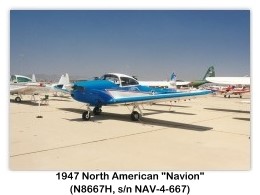
North American Navion (NA-145, NC91104, s/n NAV-4-6) on display 8/27/2005 at the 2005 Camarillo Airshow, Camarillo, CA (Photos by John Shupek)
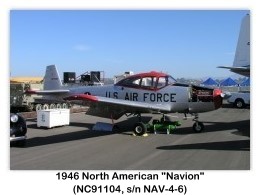




North American Navion (NA-145, NC91689, s/n NAV-4-431) on display 8/27/2005 at the Camarillo Air Show, Camarillo, CA (Photos by John Shupek)
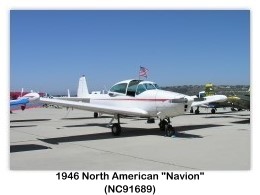

North American Navion (NA-145, N8667H, s/n NAV-4-667) on display 8/27/2005 at the 2005 Camarillo Air Show, Camarillo, CA (Photos by John Shupek)
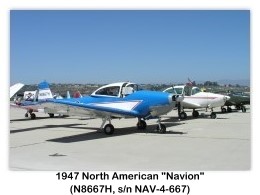

North American Navion Formation (NA-145) on display 8/27/2005 at the 2005 Camarillo, Air Show, Camarillo, CA (Photos by John Shupek)

1947 North American American Navion - Late Nite Liaison (NA-145, N91707, s/n NAV-4-178) on display 1/11/2006 at the 2006 Cable Air Show, Cable Airport, Upland, CA (Photos by John Shupek)
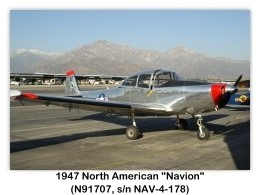
North American Navion A (N344J, s/n NAV-4-196) on display 1/7/2006 at the 2006 Cable Air Show, Cable Airport, Upland, CA (Photos by John Shupek)

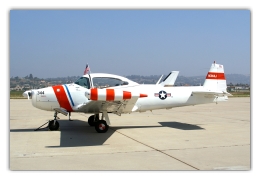

North American Navion (NA-145, N8600H, s/n NAV-4-565) on display at the 2006 Camarillo Air Show, Camarillo, CA (Photos by John Shupek)
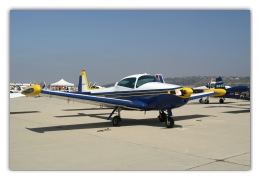
North American Navion (NA-145, N8667H, s/n NAV-4-667) on display 1/7/2006 at the 2006 Cable Air Show, Cable Airport, Upland, CA (Photos by John Shupek)
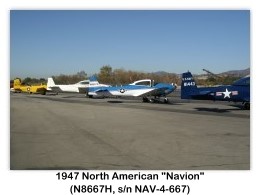
North American Navion (NA-145, N8667H, s/n NAV-4-667) on display 8/19/2006 at the 2006 Camarillo Air Show, Camarillo, CA (John Shupek Photos)
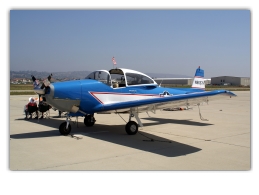
North American Navion Formation (NA-145) on display 8/19/2006 at the 2006 Camarillo, Air Show, Camarillo, CA (Photos by John Shupek)
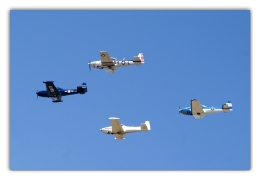
North American Navion (NA-145, N8689H, s/n NAV-4-689) on display at the 2007 Aviation Nation Airshow, Nellis AFB, Las Vegas, Nevada (Photos by John Shupek)

1947 North American Navion - Late Nite Liaison (NA-145, N91707, s/n NAV-4-178) on display 1/11/2009 at the 2009 Cable Air Show, Cable Airport, Upland, CA (photos by John Shupek)





Overview 2
The Navion is a United States single-engine, four-seat aircraft originally designed and built by North American Aviation in the 1940s. It was later built by Ryan Aeronautical Company and the Tubular Steel Corporation (TUSCO).
Design and Development 2
The Navion was originally designed at the end of World War II by North American Aviation as the NA-143 (but produced under the NA-145 designation). It was designed for the civilian market but also attracted the interest of the United States Army Air Forces. The Army Air Force ordered 83 of the NA-154 version, designated the L-17A, to be used as a liaison aircraft, personnel and cargo carrier, and trainer for the university-based Reserve Officers Training Corps flight training program, 35 of which were later converted to L-17C standard by the Schweizer Aircraft Company by fitting them with L-17B model features such as an auxiliary fuel tank.
Ryan Aeronautical Company acquired the design in 1948, and built approximately 1,200 examples over the following three years. Ryan designated the aircraft the Navion A with a 205-hp (153 kW) Continental E-185-3 or -9 and, later, the Navion B with 260 hp (194 kW) engines of either the Lycoming GO-435-C2, or optionally the Continental IO-470 engine. The Navion As became the basis for the military L-17B.
A single prototype Navion Model 72 was developed to compete for the US Air Force trainer aircraft procurement that was awarded to Beechcraft and resulted in the T-34. This Model 72 was not mass-produced.
TUSCO took over production of the Navion in the mid 1950s, manufacturing D, E and F models with a variety of enhancements including tip tanks and flush rivets.
Navion Rangemaster aircraft were manufactured from 1961 to 1976. Their production followed that of earlier canopy-model Navion aircraft. In addition to the 39.5-gallon (150 liter) main fuel tanks, the Rangemasters added tip tanks with 34 gallons (128 L) each. The total fuel capacity of 107.5 gallons (407 L) gave these Navions the range for which they are named.
TUSCO also introduced the Navion Rangemaster G model in 1960, which incorporated all previous advancements, replaced the Navion’s sliding canopy with a side door, enlarged the cabin, created five separate seats, and standardized use of tiptanks and larger, late-model Continental engines. An H Model was produced as well, very nearly the same as the G Model except for a few minor enhancements. The last few Navions were manufactured (all H Models) by Navion Aircraft Company during a short production run ending in 1976 during one of several attempts to restore the airplane to commercial viability.
Operational History 2
Pre-World War II, light civilian aircraft such as the Piper J-3 Cub and Aeronca Champion typically were made of wood or steel-tube fuselages with wooden wings. These pre-war designs were also marketed after the war, but did not sell well. The Navion was envisioned as an aircraft that would perfectly match the expected postwar boom in civilian aviation, since it was designed along the general lines of, and by the same company which produced the P-51 Mustang, generally regarded as the best Allied fighter aircraft. Republic offered an amphibious aircraft, the Seabee, Cessna offered the 195, and Beechcraft offered by far the most successful type Bonanza, which remains in production in 2009. All of these aircraft were significantly more advanced than prewar civilian aircraft and they set the stage for aircraft built from aluminum sheets riveted to aluminum formers. It was thought that wartime pilots would come home and continue flying with their families and friends under more peaceful conditions, but the postwar boom in civilian aviation did not materialize to the extent the manufacturers envisioned.
Present Day 2
As of 2009, many Navions are still flying and there is an active Navion owners community. The American Navion Society, formed in 1960, provides information to help Navion owners maintain and fly their airplanes, and organizes annual conventions and other social events for Navion owners. Another more recently formed group, Navion Skies, provides additional support.
There are no two Navions alike, in part because numerous companies produced the airplane in different parts of the country, in part due to its long service history and many approved modifications, and because without the continuous manufacturing production and support of these airplanes for most of the last 40 to 50 years, owners and third-party organizations have successfully sought numerous improvements to the aircraft on their own via FAA field approval and supplemental type certificates. The airplane has been repeatedly modified with numerous larger powerplants including the latest aircraft piston engine designs available. One Navion was fitted with a Czech built Walter turboprop allowing the airplane to climb in excess of 5,000 ft per minute.
A pair of highly-modified Navions were flown by Princeton University as the Variable Response Research Aircraft (VRA) and the Avionics Research Aircraft (ARA). The VRA was given a pair of vertical side-force-generating surfaces mounted midway between wing roots and tips and a digital fly-by-wire (DFBW) control system, first installed in 1978, that parallels the standard Navion’s mechanical control system and the fast-acting wing flaps that produce negative as well as positive lift. With these, the VRA can simulate the motions of other aircraft types through independent, closed-loop control of all the forces and moments acting on the airplane. Having completed over 20 years of research at Princeton University’s Flight Research Laboratory, the VRA and its sister ship, the Avionics Research Aircraft (which is virtually identical to the VRA but does not have side-force panels) currently are owned and operated by the University of Tennessee Space Research Institute.
Variants 2
Military Operators 2
Specifications and Performance Data (North American NA-145 "Navion" 3
Type
References